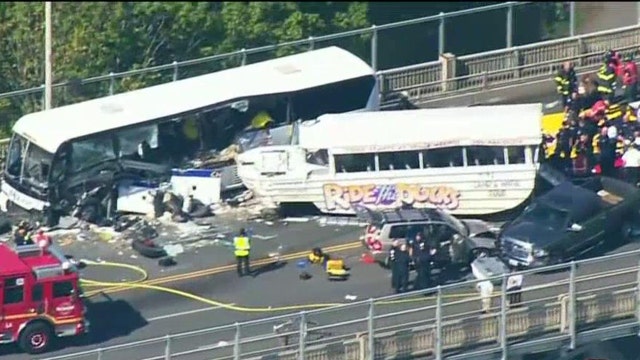Deadly crash after duck boat slams into tour bus in Seattle
Emergency crews say they've now evaluated 50 people
SEATTLE – Even before a duck boat crashed into a charter bus in Seattle, killing four international students, calls had emerged for greater oversight and even an outright ban on the military-style vehicles that allow tourists to see cities by road and water.
Critics say the large amphibious vehicles are built for war, not for ferrying tourists on narrow city streets.
"Duck boats are dangerous on the land and on the water. They shouldn't be allowed to be used," Robert Mongeluzzi, a Philadelphia attorney, said Friday, renewing his call for a moratorium on their operation nationwide.
His firm represented the families of victims in a deadly 2010 crash near Philadelphia. A tugboat-guided barge plowed into a duck boat packed with tourists that had stalled in the Delaware River, sinking the boat and killing two Hungarian students.
"They were created to invade a country from the water, not to carry tourists," said Mongeluzzi, whose firm now represents the family of a woman killed in May by an amphibious vehicle in Philadelphia.
Some attorneys also question the focus of the drivers. In Seattle, tours are complete with exuberant operators who play loud music and quack through speakers.
"This is a business model that requires the driver to be a driver, tour guide and entertainer at the same time," said Steve Bulzomi, the attorney for a motorcyclist who was run over and dragged by a duck boat that came up behind him at a stoplight in Seattle in 2011.
About 45 students and staff from North Seattle College were traveling Thursday to the city's iconic Pike Place Market and Safeco Field for orientation events when witnesses said the duck boat suddenly swerved into their oncoming charter bus.
Brad Volm of Philadelphia was driving in another vehicle and said the amphibious vehicle's left front tire appeared to lock up.
Authorities say it's too soon to determine what caused the crash that killed four students from Austria, China, Indonesia and Japan. A National Transportation Safety Board team arrived Friday to lead an investigation that typically takes a year, the agency said.
The president of Ride the Ducks Seattle said his main concern was the families of the victims. Brian Tracey told The Associated Press that "we will get to the bottom" of the crash.
Tracey said 36 people were on the vehicle, whose driver had Coast Guard certification and a commercial driving license. All company drivers are required to take continuing education classes, he said.
"We take these issues very seriously," Tracey said.
Bulzomi said the latest incident should compel authorities to take action.
"I would hope everybody would take a serious look at whether this is a real good idea for the streets of Seattle," he said.
Seattle Mayor Ed Murray said Ride the Ducks Seattle has voluntarily sidelined its vehicles for the time being. He wasn't sure whether the duck boats would be allowed to continue in the city but said the NTSB was interested in duck-boat safety because such vehicles are operating in other cities.
The federal agency's investigation in Seattle is the first time it is looking into a duck-boat crash on land, board member Earl Weener said at a news conference Friday. The NTSB has scrutinized the vehicles several times when they have been in accidents on water, he said.
The safety of the amphibious boats has been questioned before. They are remnants from when the U.S. Army deployed thousands of amphibious landing craft during World War II. Once the war was over, some were converted to sightseeing vehicles in U.S. cities.
Thirteen people died in 1999 when an amphibious boat sank to the bottom of Lake Hamilton in Arkansas in an accident the NTSB blamed on inadequate maintenance.
Bulzomi, the lawyer for the Seattle man struck by a duck boat in 2011, said he found two other recent cases in which duck boats rear-ended vehicles at stoplights. In both cases, the drivers told police they couldn't see the other vehicle because of the height of the duck boats, he said.
Thursday's crash happened as North Seattle College students were touring the city. The collision on the Aurora Bridge, which carries one of the city's main north-south highways over picturesque Lake Union, left behind a tangled mess of twisted metal and shattered glass.
Authorities say 51 people were taken to area hospitals, and 14 remained in intensive care at Seattle hospitals.
Students, faculty and staff of North Seattle College, a diverse school of about 14,000 students, gathered on campus Friday to grieve.
"There are still wounds in our heart," North Seattle College President Warren Brown said later at a news conference.


